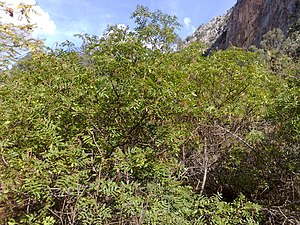Note: This is a project under development. The articles on this wiki are just being initiated and broadly incomplete. You can Help creating new pages.
Rhus coriaria
Rhus coriaria is a deciduous shrub that can grow up to 3 metres tall. The plant is harvested from the wild for local use as a food, medicine and source of materials. It is sometimes grown as an ornamental in garden. The plant is classified as 'Vulnerable' in the IUCN Red List of Threatened Species(2013).
Uses
Parts Used
Chemical Composition
In total 191 compounds were identified in sumac fruit including, 78 hydrolysable tannins (Gallic acid), 59 flavonoid such as, Apigenin, 40 other compounds such as Butein, 9 anthocyanins such as Cyanidin.[2]
Common names
| Language | Common name |
|---|---|
| Kannada | |
| Hindi | |
| Malayalam | |
| Tamil | |
| Telugu | |
| Marathi | |
| Gujarathi | |
| Punjabi | |
| Kashmiri | |
| Sanskrit | |
| English |
Properties
Reference: Dravya - Substance, Rasa - Taste, Guna - Qualities, Veerya - Potency, Vipaka - Post-digesion effect, Karma - Pharmacological activity, Prabhava - Therepeutics.
Dravya
Rasa
Guna
Veerya
Vipaka
Karma
Prabhava
Habit
Identification
Leaf
| Kind | Shape | Feature |
|---|---|---|
Flower
| Type | Size | Color and composition | Stamen | More information |
|---|---|---|---|---|
| {{{5}}} |
Fruit
| Type | Size | Mass | Appearance | Seeds | More information |
|---|---|---|---|---|---|
Other features
List of Ayurvedic medicine in which the herb is used
Where to get the saplings
Mode of Propagation
How to plant/cultivate
Rhus coriaria is not very cold-hardy, tolerating short-lived temperatures down to around -5°c when it is fully dormant, and is unlikely to succeed outdoors in any but the mildest parts of the temperate zone.[4]
Commonly seen growing in areas
Photo Gallery
- Თუთუბო Rhus coriaria Gerbersumach, Gewürzsumach (2).JPG
- Თუთუბო Rhus coriaria Gerbersumach, Gewürzsumach.JPG
References
- ↑ Indian Medicinal Plants by C.P.Khare
- ↑ Chemical constituents
- ↑ [Morphology]
- ↑ Cultivation
External Links
- Pages with broken file links
- Ayurvedic Herbs known to be helpful to treat Dysentery
- Ayurvedic Herbs known to be helpful to treat Haemoptysis
- Ayurvedic Herbs known to be helpful to treat Conjunctivitis
- Ayurvedic Herbs known to be helpful to treat Diarrhoea
- Herbs with Immature fruits used in medicine
- Herbs with Leaves used in medicine
- Habit - Deciduous shrub
- Index of Plants which can be propagated by Seeds
- Index of Plants which can be propagated by Cuttings of half-ripe wood
- Index of Plants which can be propagated by Root cuttings
- Index of Plants which can be propagated by Suckers
- Herbs that are commonly seen in the region of Rocky places
- Herbs that are commonly seen in the region of Waysides
- Herbs that are commonly seen in the region of On limestone
- Herbs



